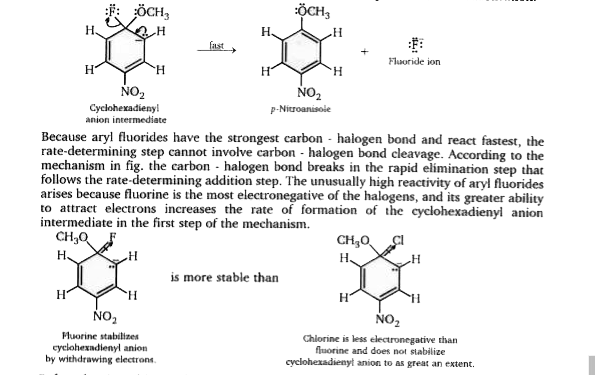
above reaction is an example of Nucleophilic aromatic substitution. Which of the following halide (-X) is most readily replaced.Solution in Telugu
_F
−Cl
−Br
−I
The correct Answer is:A
Fluoride is the most reactive leaving group in nucleophilic aromatic substitution, iodide the least reactive.

Step 2: Elimination stage. Loss of halide from the cyclohexadienyl intermediate restores the aromaticity of the ring and gives the product of nucleophilic aromatic substitution.

Before leaving this mechanistic discussion, we should mention that the addition elimination mechanism for nucleophilic aromatic substitution illustrates a principle worth remembering. The words activating and deactivating as applied to substituent effects in organic chemistry are without meaning when they stand alone. When we say that group is activating or deactivating, we need to specify the reaction type that is being considered. A nitro group is a strongly deactivating substituent in electrophilic aromatic substitution, where it markedly destabilizes the key cyclohexadienyl cation intermediate.
Topper's Solved these Questions
- AROMATIC COMPOUNDS BOOK - MS CHOUHANCHAPTER - AROMATIC COMPOUNDS EXERCISE - LEVEL-2
11 Videos
- AROMATIC COMPOUNDS BOOK - MS CHOUHANCHAPTER - AROMATIC COMPOUNDS EXERCISE - LEVEL-2 (COMPREHENSION)
16 Videos
- AMINESBOOK - MS CHOUHANCHAPTER - AMINESEXERCISE - Level-2
1 Videos
- BIOMOLECULES BOOK - MS CHOUHANCHAPTER - BIOMOLECULES EXERCISE - LEVEL - 2
5 Videos
Similar Questions
Each of the six compounds shown at the bottom of the page has two aromatic (benzene) rings. In each case the two rings are different and are labeled A & B. If an electrophilic substitution, such as nitration or bromination, is carried out on each compound, then identify which ring (A or B) will be preferentially attacked, and indicate the orientation of the substitution (ortho/para, meta or all sites).

View SolutionGiven is the energy profile diagram of nitration of benzene using mixed acid. (HNO3+H2SO4)

Identify (x) in above reaction :
View SolutionFive amine syntheses are outlined below. In each reaction box enter a single letter designating the best reagent and conditions selected from the list at the bottom of the page.


View SolutionMatch the colume (I) and Column (II). (Matrix)

View SolutionAromatic Nucleophilic Substitution Reaction
View SolutionWhich of the following compound is most reactive in the nucleophilic aromatic substitution reaction with NaOH ?
View Solution
above reaction is an example of Nucleophilic aromatic substitution. Which of the following halide (−x) is most readily replaced.
View SolutionWhich of the following halide is most reactive towards Nucleophilic substitution reactions ?
View SolutionWhich of the following halids would undergo nucleophilic substituion most readily ?
View SolutionWhich group CANNOT be introduced in an aromatic ring by the nucleophilic substitution of halide group?
View SolutionWhich of most reactive towards nucleophilic aromatic substitution.
View SolutionWhich of the following gives the most readily nucleophile substitution in haloarenes?
View SolutionAlkanes undergo free radical substitution, aromatic compounds undergo electrophilic substitution and alkyl halides undergo nucleophilic substitution reactions
View SolutionWhich of the following halides would undergo nucleophilic substitution most readily (SN1)?
View SolutionWhich of the following halides is most reactive towards nucleophilic substitution reactions ?
View SolutionWhich of the following halides is most reactive towards nucleophilic substitution reactions ?
View Solution
